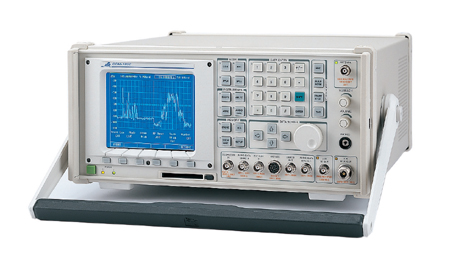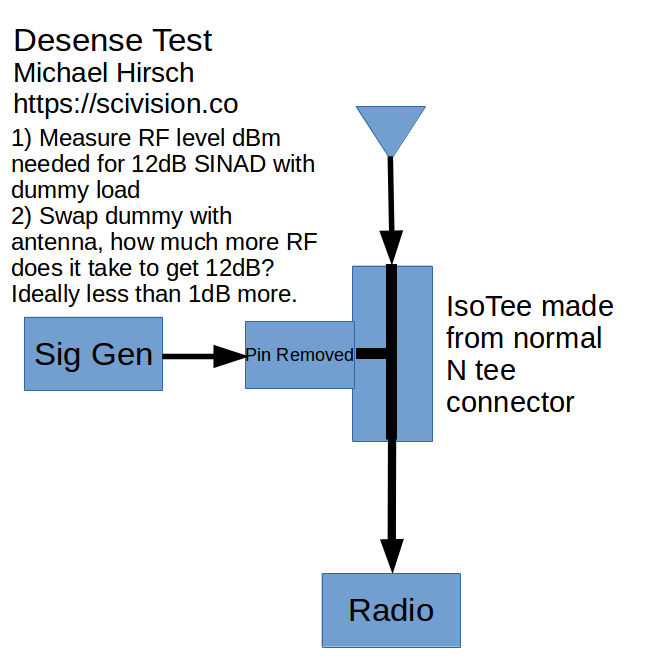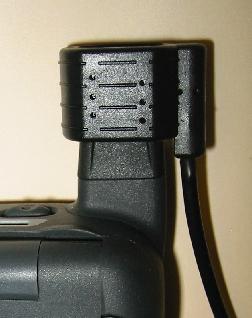Nextel 800 MHz Police radio interference
Public safety is ensconced below 860 MHz while Nextel blasts away with wideband CDMA above 862 MHz. A police station was missing every fifth or so radio transmission. This immediately raised some ideas, since the trunking system was 5 channel, of the type that used a low-speed subaudible data control channel shared with voice.
While transmissions that worked were heard crystal clear, due to the quieting effect of FM, we know that there is a rather non-linear relationship between C/N and SNR. That is, the FM improvement factor once you’re over the signal level where popping and cracking stops puts you quickly to the 35dB maximum SNR typical of FM communication radios. The link could be weak but you’ll only intermittently see problems.
We used Radio Mobile Deluxe for a “radio link” path simulation as seen at the top of this article. The over 40 km path length despite the mild terrain leads to only 0.2 Fresnel zone clearance instead of the desired ≥ 0.6. Since this system had only one central transmitter for the county, and the police station antenna was on a tower with a good gain omni antenna, there wasn’t much to do. The omni antenna had to stay to allow for backup simplex (radio to radio) communications in case the main tower went down–they weren’t going to buy a second base radio or swap yagi to omni antennas in that case.

Radio Path profile
The deficient design of the county-wide 800MHz system caused a variety of problems due to having the single central transmitter on a tall hill and a very tall tower. You just can’t be 40 km from a transmitter and get a solid signal when safety of life transmissions are concerned. Yes, ham radio operators go over twice that distance on VHF/UHF repeaters, but two key distinctions are:
- Ham repeater frequencies are generally afforded far more co-channel and adjacent channel protection than commercial frequencies
- Ham radio operators will tolerate far more static, fading, repeating transmissions than police officers in hot pursuit
In fact, given terrain in other parts of the county, some places only 20 km from the tower had problems with reception. Yes, there was a receiver voting system, but in a trunking system, you have to hear the base station before you can initiate voice communications! You can’t say “man down” on a trunked system even next to the voting receiver if you can’t hear the base transmitter. Exception is for the emergency button, the protocol designers were smart enough to allow the emergency unit ID to go through even one-way.
On-Site Observations
We set a conventional receiver to each of the channels and listened for the 10-second periodic “kerchunk” of each repeater. We noticed the repeaters were roughly the same signal strength by ear. No other complaints had come in besides the usual. We did a few test transmissions at the police station from their radio, tested their radio with an Aeroflex COM-120C service monitor, checked the SWR with a Bird 43 wattmeter, all was well.

Aeroflex COM-120C service monitor. Photo copyright Test Equipment Connection
The spectrum analyzer showed the 5 repeater channels were approximately equal in strength, allowing for fading and instrument accuracy. The received signal amplitude was in line with the path loss predictions, keeping in mind the confidence interval in the Longley-Rice propagation model. We reprogrammed the police base station to listen directly to each of the channels. We noticed a clear SNR deficiency on only one channel, despite the spectrum analyzer showing nearly equal signal strengths and equal background noise level within the sensitivity of the spectrum analyzer. The spectrum analyzer intrinsic noise floor was on the order of -100dBm for the resolution bandwidth.
Spectrum analyzer resolution bandwidth trades resolution for update rate. Large resolution bandwidth gives very rounded-off traces at decent update times. Small resolution bandwidth gives fine traces at slow update times. Nextel’s iDEN signals fill the channel with a fairly uniform spectrum. You can’t zero in on a carrier like you can with analog transmissions and wait for the analyzer to update.
The “desense” test uses a special T-connector called an isotee that passed straight through between antenna and radio, and the T port had the center pin removed. The isotee provides controlled (at least at each frequency) isolation such that a signal generator connects to the isolated port, and the radio is connected to the antenna via the other two ports.

isotee diagram for desense check
Four channels were normal, perhaps less than a dB desense. The fifth channel had perhaps 10-20 dB of degradation, fluttery time-varying. Changing the signal generator frequency slightly did not generate beat notes. Tuning the radio/sig gen to one 25kHz channel either side didn’t have the interference. The interference was fluttery but constant otherwise, no duty cycle.
Long-distance Nextel iDEN co-channel interference

interference path Nextel to public safety
Nextel despite purchasing up SMR licenses in those days did not put sites at the license coordinates necessarily. They took advantage of the SMR regulation allowing different site location as long as the license footprint was not exceeded. This is where the cell phone DXing came in. We used a Wilson antenna adapter on a Nextel i850. Dialing # , * , Menu, Right to go into field test mode, gave current frequency and signal strength in dBm, among other parameters.

Wilson Antenna coupler slid over Motorola i850 antenna, allowing use of external antenna for far greater range (photo copyright Wilson Antenna)
There was not cell service locally available at ground level. With an external antenna the Nextel signal was there. he Nextel phone showing similar signal strength on the Nextel signal as what the non-directly observable interference might be.
Nextel field engineering staff were a bit surprised that a Nextel tower over 90 km away could be a bother to a police radio. We noted the weak desired signal, and the part of the interference path that went over water. This configuration was conducive to thermal inversion layers. Superrefraction can make radio waves travel unexpectedly long distances. He put in a channel change request. The desense test then showed all repeater channels were good. Hopefully someone at Nextel did a license search to give a wider co-channel geographic exclusion zone for public safety licensees. It would be a simple FCC license search away.